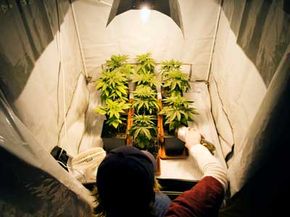Setting Up a Grow House
For the avid marijuana grower, dealing with lawmakers, police officers and distributors can be quite a hassle. But on top of the various human demands, they have a plant to appease. Cannabis sativa isn't interested in medical findings, legal jurisdiction, bribes or profits. It needs sunlight, water, warmth and nutrients. If growers give the plants what they need, then they can harvest all the green gold they want.
Of course, most homes are designed to house human families -- as opposed to, say, a few hundred cannabis plants. To meet the needs of a large, indoor marijuana growing operation, some do-it-yourself additions are required. In larger, professional operations, the costs of outfitting a home can cost hundreds of thousands of dollars, transforming the home into a closed growing environment. Some of these grow houses are home only to plants and the machines that keep them alive.
Advertisement
What kind of digs do these plants require? First, marijuana plants have to sink their roots into something. Most growers use a calculated mixture of nutrients, fertilizer and soil. Another method is to employ hydroponics, in which the grower uses nutrient solutions instead of soil and supports the plants in specially designed containers, trays and tables. Second, plants need water, which demands either manual or automated watering, such as a drip system. To prevent overwatering and water damage to the house, growers have to make sure proper drainage is in place. Growers often try to lock all this moisture inside with airtight seals and insulation, but sometimes dehumidifiers are required if the air becomes too damp.
Water and nutrient-rich soil won't help a plant one bit, however, if it doesn't get enough sunlight. Given the limits of indoor growing, artificial lighting is required. Luckily for grow houses, horticulture and aquarium lights are readily available. After all, not everyone who grows plants indoors is in the marijuana business. Successful grow house operators recommend using 1,000-watt horticulture bulbs, each of which can sustain 15 to 20 plants [source: Cannabis Culture]. To put that in perspective, incandescent light bulbs typically range between 40 and 150 watts, while compact fluorescent light bulbs use between 9 and 52 watts.
By controlling how much light the plants get, growers can also speed up the growth cycle for the female plants that produce the valuable buds. It's as if your boss secretly set all the clocks in the office back a few hours to squeeze a little extra work out of everyone. During the initial growth period, grow house crops enjoy 16- to 18-hour days to hurry development. Toward the end of the growth cycle, growers shorten the days to cause the plants to flower. By employing this method and growing only the bud-producing female plants, grow house operators can produce as much as four times as much pot as an outdoor operation [source: New Yorker]. The plants are typically scrawnier, but contain more of the THC-laden resin that makes marijuana use so popular.
How hot can a room full of 1,000-watt light bulbs get? In the next section, we'll look at the problems these lights pose and how growers protect their investment from pests and diseases.
